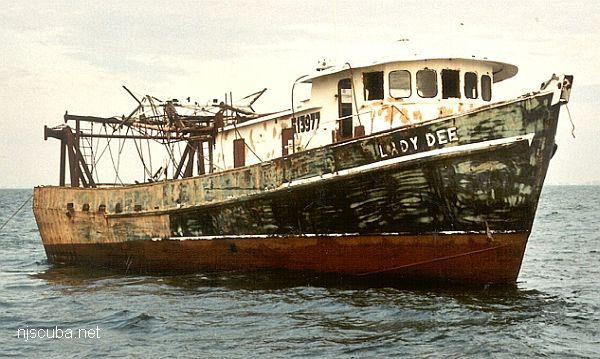Water Composition (5/5)
Upwellings & Fishkills
In coastal areas, strong offshore ( land to sea ) winds can push surface waters away from the land. Cold nutrient-rich water then flows up from the deep up to replace it, thermocline or not, in an event known as an upwelling. Upwellings usually result in localized algae blooms, which are sometimes intense enough to cause low-oxygen events and even fishkills. Such a fishkill, of unprecedented proportions, occurred in 1976, affecting almost the entire marine environment off the New Jersey coast.
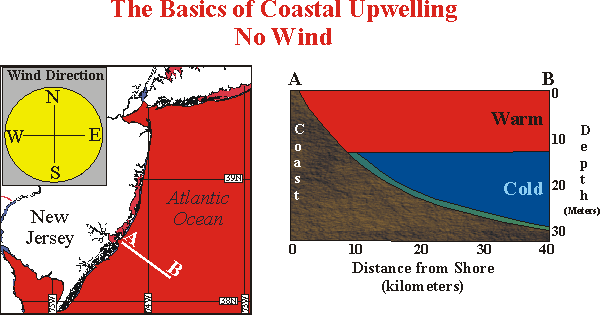
During the summer months, the surface of the ocean near our coast is heated by the sun. This warming causes stratification (warm surface/cold bottom). Typically, winds during our summer months are from the southwest, bringing all that hot humid air up from the Gulf of Mexico. These winds do not blow that surface layer directly to the northeast, but to the southeast. This 90-degree difference in wind and water current direction is due to the spin put on the water by the earth's coriolis force.
When the warm surface water is blown offshore, the cold bottom water rises, like a conveyor belt, and hits the beach. This cold water also brings sediment up from the bottom. Phytoplankton (microscopic plants) which float along the surface, used this sediment as food and bloom, causing the water to become green and murky. The figure above demonstrates what happens at the surface and below the water when winds blow from the southwest along the New Jersey coast. This is why the beaches can be so cold and "dirty" on the warmest days of the year.
The Ocean Fishkill of 1976
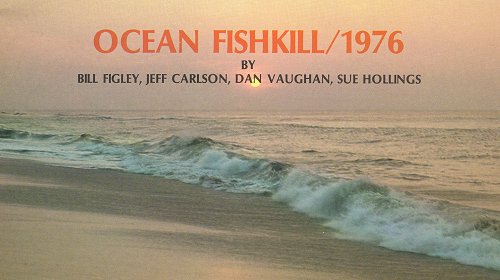
by Bill Figley, Jeff Carlson, Dan Vaughan, Sue Hollings
If you are an avid marine fisherman, you probably will not forget the summer of 1976 - dead and dying fish in the surf and inlets; wrecks devoid of fish, crabs, lobsters, and other marine organisms; disrupted fish migrations; brown scum washing up on beaches; and extensive streaks of red water along the surf.
The first indications of trouble were received from sport divers who found dead and dying fish and shellfish on wrecks located off the northern coast of New Jersey in late June of 1976. The divers noted that the bottom waters were extremely murky and that a dark scum covered the wrecks and bottom. In response, the National Marine Fisheries Services ( NMFS ) from the Sandy Hook Lab and the Marine Fisheries Section of DEP's Division of Fish, Game, and Shellfisheries embarked on sampling programs designed to assess water quality in the reported area. Water samples indicated severely low concentrations of dissolved oxygen in bottom layers. The murky water and bottom scum were found to be the result of a thick bloom of algae that consisted primarily of Ceratium tripos. Soon, reports of similar mortalities were being received from many offshore areas as far south as Atlantic City.

More than 3,000 square miles of New Jersey's coastal waters suffered severe depletion of dissolved oxygen near the bottom. During July and August of 1976, bottom-dwelling fish were absent from an area comprising more than 1,100 square miles.
As the seriousness of the problem became more evident, sampling efforts by the NMFS and the Division were expanded to cover a greater portion of the New Jersey coast. These investigations indicated that bottom waters in an area of 3,000 square miles extending from four to about sixty miles offshore and from Sandy Hook to below Atlantic City were either devoid of oxygen ( anoxic ) or had very low ( hypoxic ) concentrations of dissolved oxygen. Slow-moving and attached organisms, such as crabs, clams, scallops, starfish, worms, and barnacles, perished in areas where the anoxic conditions persisted. Fortunately, most fish were able to sense the gradually declining oxygen levels and avoided pockets of anoxic water. However, fish species such as eelpout, cunner, and sea bass, which depend upon wrecks and other obstructions for protection, were reluctant to leave such shelters and consequently suffered high mortalities. Through sample trawling, NMFS biologists found that fish were completely absent from more than 1,100 square miles of ocean bottom during August.
The impact of the "bad water" on the State's marine fisheries resources was disastrous. About 69 percent ( 19 million bushels ) of the State's most valuable fishery stock, the surf clam, was destroyed; the potential economic value of this lost resource amounted to more than $430 million. Losses to the lobster industry amounted to more than $1 million. The inshore trawler fishery lost more than $5 million. Bluefish avoided the bad water and did not venture into coastal waters off northern New Jersey. Tuna remained well offshore. Bottom species - fluke, sea bass, and ling - had to vacate traditional offshore grounds. Charter and party boats dependent on these species lost future fares from hesitant and disappointed fishermen, had to cancel trips and were forced to use more fuel to reach the dispersed fish. In all, the State's charter and party fleet lost an estimated $1.7 million during 1976. In addition, biologists suspect that future stocks may have been damaged because of the disruption of the spawning activities of many species and of the mortality of fish eggs and larvae drifting through anoxic waters.
An Explanation of the Kill
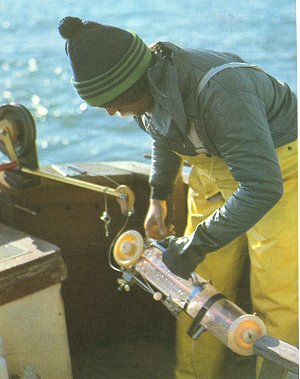
water sample off Barnegat Light.
The immediate causes of fish and shellfish mortalities were the lack of sufficient concentrations of oxygen in bottom waters and the presence of poisonous hydrogen sulfide gas in anoxic areas. The depletion of dissolved oxygen occurred in the following manner:
During the late spring, ocean water temperatures vary little from surface to bottom. Oxygen reaches surface waters through diffusion from the air and is also produced by algae during photosynthesis. It is circulated through the water column by diffusion, wave action, and various currents. As the sun warms the surface layers and the colder, heavier waters sink to the bottom, two layers, one of warm water and one of cold water, are formed.
Between the layers is a thin zone called the thermocline in which temperature declines rapidly with depth. This condition is especially noticeable while swimming in lakes and ponds - diving underwater, the swimmer will suddenly encounter an abrupt drop in temperature. During 1976, the thermocline extended from 30-to 60-foot depths. Since the bottom layer is significantly heavier than the surface, the two layers resist mixing ( like oil and vinegar. ) the thermocline acts as a barrier to diffusion of oxygen between the surface and bottom. Thus the oxygen supply trapped in the bottom layer must be sufficient to sustain all of the living organisms through the summer, and normally it is capable of doing this. During 1976, however, the decay of tremendous quantities of Ceratium algae which died and slowly sank to the bottom, and the chemical and bacterial decomposition of other organic matter, placed additional demands on the limited oxygen supply. During July and August of 1976, most of the bottom waters off the coast of New Jersey had dissolved oxygen levels below 1.4 milliliters per liter ( mI/I ), the concentration below which most fish species begin exhibiting signs of serious stress, and a large area situated off Long Beach Island had absolutely no dissolved oxygen.

Inshore waters less than 60 feet deep were generally not affected because no thermocline was present to trap bottom waters and wave action was able to circulate oxygen throughout the water column. Some species were forced to spend the summer within this narrow band along the shore. At many times during the summer, sport fishermen were able to make large catches ( perhaps too large ) of fluke in the inlets or just outside the surf.
What caused the anoxic water condition?
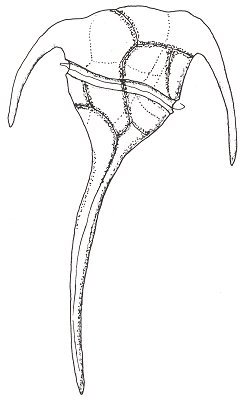
which experienced a tremendous
population bloom during 1976.
The immediate response of sport and commercial fishermen was that the kill was caused by sludge dumping. They believed that the brown and black scum, which covered wrecks and occasionally washed up onto beaches, was raw sewage. In most cases, however, the scum was found to be gelatinous masses of decayed algae.
NMFS biologists believed the anoxic water condition was due in large part to unusual weather conditions. First, surface air temperatures were unusually high during the first six months of 1976 ( 2-5 F above normal, ) resulting in a more rapid warming of surface waters. Second, river runoff began two months earlier in the spring than usual. Third, during February and March, the predominant winds were from the south. Finally, storm activity was very low during the spring and summer. All these factors favored the early formation of a thermocline. Consequently, the oxygen supply below the thermocline was subjected to two additional months of oxygen-using activity by marine organisms. By late May, oxygen concentrations were as low as they normally are in July. The combination of early thermocline formation and the decomposition of tremendous quantities of Ceratium algae and other organic matter resulted in the eventual exhaustion of oxygen supplies in many areas off the New Jersey coast.
With regard to the fishermen's theory, no one is really certain what role sludge dumping played in the anoxic water condition of 1976. The ocean off New York and New Jersey now receives nutrients ( phosphates and nitrates ) and organic material from many sources - the dumping of sewage sludge, dredge spoil, and chemical wastes; municipal sewage outfall; river runoff which includes treated and untreated sewage; industrial wastes and farm fertilizers; sewage from pleasure and commercial boats; and more. The nutrients act as fertilizers and may stimulate algae blooms; then, as the algae die and sink to the bottom, their bodies are decomposed by bacteria. Other organic materials in the water are decomposed chemically and by bacteria. The decomposition process utilizes the oxygen supply that is necessary for all marine organisms commonly associated with clean water.
The Division's Program
The future of New Jersey's economically valuable commercial and recreational marine fisheries and possibly its ocean-based tourist trade is dependent upon the health of the State's coastal waters. At present, no one is certain of the ultimate cause of the anoxic waters of 1976 or if this condition will reoccur in future years.
In an attempt to gather the data needed to identify more specifically the primary factors responsible for this problem, DEP's Division of Fish, Game, and Shellfisheries continued where it left off in 1976 with an intensive ocean sampling program through the summer and fall of 1977. The primary objectives of the sampling cruises were to monitor dissolved oxygen concentrations, temperatures, and nutrient levels of nearshore ocean waters. Fortunately, conditions were improved over those of 1976. No areas were sampled that were completely devoid of oxygen. However, a large area extending from Manasquan to Beach Haven between one-half and twelve miles offshore had dissolved oxygen concentrations between 1 and 2 mI/I during August. These levels are considered critical, but not lethal, to fish and invertebrate life.
Another phase of the study was to investigate the flow of nutrients and organic material from northern inlets into the ocean. Of the four inlets sampled ( Barnegat, Manasquan, Navesink, and Raritan River, ) the Raritan River had much greater inputs of nitrogen and carbon compounds.
During the spring of 1978, sampling operations will continue with special emphasis on monitoring algae and benthic ( bottom-dwelling organisms ) populations. The benthic survey will provide the data needed to assess the recovery of the resident populations that were decimated by the anoxic water.
Determining the primary factors that led to the anoxic water condition off our coast is only the initial step in safeguarding one of New Jersey's most valuable natural resources.
This article first appeared in New Jersey Outdoors - July / August 1978

